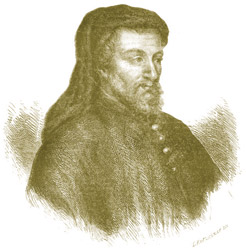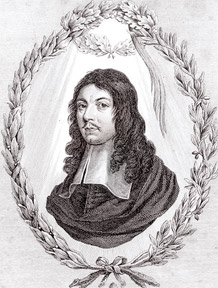The ironic mode: ‘Let be be finale of seem’
 Previously we considered the first of the two great modes of literary
expression propounded by MI Kuruvilla, namely the metaphoric. Let us now
consider the second - the ironic. If metaphor seeks to discover the
similarity between different realms of experience, the aim of irony is
virtually the opposite: to expose the difference between the signifier
and the signified or, to put it more simply, between what is said and
what is actually meant. Previously we considered the first of the two great modes of literary
expression propounded by MI Kuruvilla, namely the metaphoric. Let us now
consider the second - the ironic. If metaphor seeks to discover the
similarity between different realms of experience, the aim of irony is
virtually the opposite: to expose the difference between the signifier
and the signified or, to put it more simply, between what is said and
what is actually meant.
Here again, as in the case of metaphor, Yeats furnishes us with a
familiar example; this time the line from his poem of the same title,
“Men improve with the years.” That men develop greater sagacity as they
age is a commonly held assumption. In this instance, however, it is an
ironic statement since the evidence of the poem is that, in the matter
of becoming infatuated with a beautiful young woman, the poet though
older is no less susceptible than when he was a young man.
As in the case of metaphor, Kuruvilla was referring to irony not
merely as a figure of speech or literary device but as a literary way of
thinking or approach to experience. And in this sense it is as much a
manifestation of the creative imagination as is metaphor. Coleridge, we
recall, spoke of the imagination as having the power to “balance or
reconcile opposite or discordant qualities” and achieve “sameness with
difference.” This is what irony does as an inversion, as it were, of the
function of metaphor. The latter demonstrates the essential unity
between disparate experiences. Irony, on the other hand, reveals a
disparity of ideas within a single expression.
 |
|
Geoffrey
Chaucer |
 |
|
Andrew
Marvell |
We noted at the start of this series that it was Chaucer who
introduced the ironic technique to creative writing in English. His
Canterbury Tales and their Prologue are replete with examples of ironic
usage and we considered one such from the portrait of the Prioress. Here
is another from the portrait of the Friar who, we are told, has a flair
for hearing the confessions of, and granting absolution to, repentant
sinners who are generous with their donations. “For unto a povre ordre
for to yve (For to donate to a poor order) Is signe that a man is wel
yshryve; (Is a sign that a man has confessed well) For if he yaff, he
dorste make avaunt, (For if he would give, he –the friar-would venture
to claim) He wiste that a man was repentaunt; (He knew that the man was
repentant) The professed meaning is that a sinner’s readiness to donate
to the Friar’s order was indicative of the genuineness of his
repentance, whereas the real meaning is that the Friar’s assertion to
this effect was precisely for the purpose of attracting such donations
for his personal enrichment.
Thus irony can be seen as a means of distinguishing between
appearance and reality, between what is professed or presented and what
really is the case. Its effectiveness lies in the fact that its
technique of communicating two meanings within a single statement is
imitative of real life, where people often deceive either themselves of
others as to their true motivations or intentions.
Irony is also very much a part of Metaphysical wit as practised not
so much by Donne, who was insufficiently detached from his subject
matter to be capable of it, as by Marvell, “the resolved soul.” Eliot
referred to this aspect of Marvellian wit as “a recognition, implicit in
the expression of every experience, of other kinds of experience that
are possible.” The finest example of this is ‘The Horatian Ode upon
Cromwell’s Return from Ireland.’ The poem is purportedly a paean to the
conquering hero who, having violently seized power in 17th century
England and having had its monarch executed, has gone on to crush an
uprising of the colonized Irish. The poet comments on the latter episode
as follows: “And now the Irish are asham’d To see themselves in one Year
tam’d: So much one Man can do, That doth both act and know. They can
affirm his Praises best, And have though overcome confest How good he
is, how just, And fit for highest Trust.” Such praise is doubtless
forthcoming from Cromwell’s admirers but it is here attributed to the
very people he has vanquished. Thus the acclamation of his goodness,
justice and trustworthiness becomes a tacitly ironic acknowledgment that
might is right. Indeed, the entire poem has the effect not, in Pope’s
phrase of “damning with faint praise”, but of faintly damning with great
praise the actions and motivations of its subject. As such, the poem
enables us to realise how irony, in the hands of its best practitioners,
becomes a literary attitude or technique in the handling of one’s
subject matter.
Much the same can be said of Chaucer’s approach in the Canterbury
Tales and Prologue. The very opening lines of the latter suggest that
what enthuses folk to go on pilgrimage is the advent of the refreshing
and regenerative season of Spring, Therefore their motivation would seem
to be as much the holiday spirit as religious devotion. And having
gained some insight into the character of those who make up the pilgrim
party, we realise that piety is far from being the outstanding
characteristic of the majority of them. Thus the entire concept of such
folk embarking on a pilgrimage becomes ironical.
Chaucer’s irony is good humoured and comic. Marvell’s is subtle and
urbane. But in his ‘The Emperor of Ice Cream’ Wallace Stevens manifests
a type of irony that is positively grim, if not cynical. There is, in
fact, no specifically ironic statement in the poem. What is ironic is
the poet’s entire approach to his subject, which is the death of an old
woman whose corpse is laid out in her parlour. The mourners, however,
are not here but in the kitchen where preparations are afoot for the
customary wake for the dead. What prevails here is not a funereal but a
festive atmosphere, with ice-cream making taking centre stage and
desultory flirtations taking place between the young men and women who
have come over to help with the preparations. Little interest, let alone
respect, is being shown to the dead.
Then Wallace comes out with the famous couplet, “Let be be finale of
seem; The only emperor is the emperor of ice cream.” The last line
suggests that what really rules on such occasions is not the sober
remembrance of our mortality but the insistence on enjoying life under
the pretext of honouring the dead, ice cream being the symbol of such
cheap pleasure-seeking.
In the previous line Stevens laconically calls for recognition of the
reality behind the appearance, so that the mourning occasion (what
“seems”) is seen for what it really is (“be”), a pretext for merriment.
“Let be be finale of seem” therefore becomes an apt aphorism embodying,
as it does, the raison d’etre of the ironic mode of creative expression.
|



